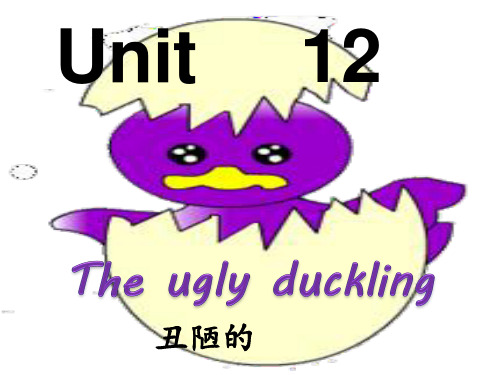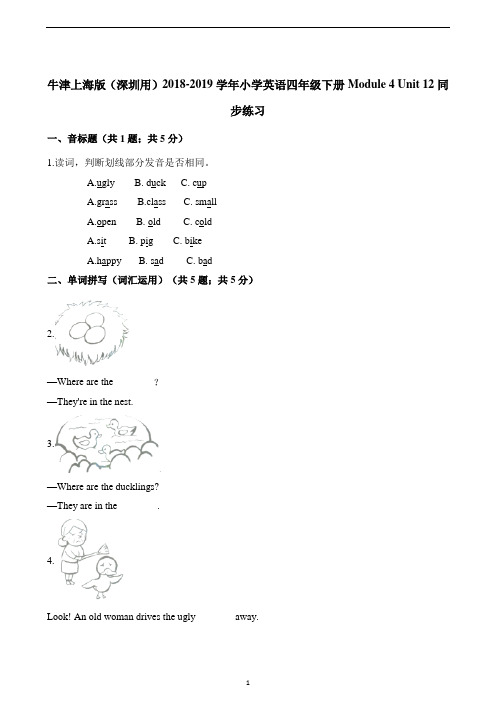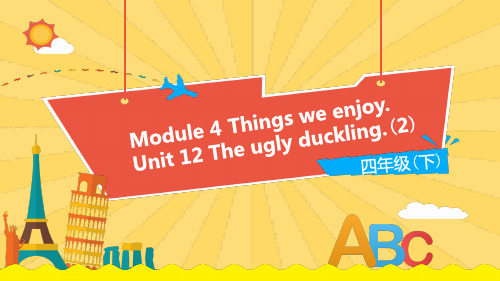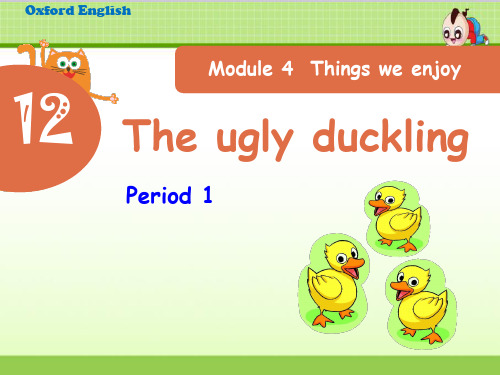【优质】小学英语沪教版四年级下册Module4Unit 12《The ugly duckling》优质公开课教案第二课时
- 格式:doc
- 大小:45.00 KB
- 文档页数:7



牛津上海版(深圳用)2018-2019学年小学英语四年级下册Module 4 Unit 12同步练习一、音标题(共1题;共5分)1.读词,判断划线部分发音是否相同。
________A.ugly B. duck C. cup________A.grass B.class C. small________A.open B. old C. cold________A.sit B. pig C. bike________A.happy B. sad C. bad二、单词拼写(词汇运用)(共5题;共5分)2.—Where are the________?—They're in the nest.3.—Where are the ducklings?—They are in the________.4.Look! An old woman drives the ugly________away.5.The sheep like eating ________.6.—How many________are there? —There is one.三、单选题(共6题;共12分)7.There three pens on the desk.A. haveB. areC. is8.Mother Duck three eggs.A. hasB. haveC. is9.Mother Duck the ducklings.A. feedsB. feedC. feeding10.The big egg later.A. openB. opensC. does11.The can swim in the water.A. catB. fishC. bird12.It's ugly bird.A. aB. anC. \四、补全对话(共1题;共5分)13.读一读,选择句子补全对话。
A. It's behind the hill.B. Where's your home?C. What do you like doing?D. Can you hop?E. Do you like swimming?Rabbit: Hello, Duck.Duck: Hi, Rabbit.Rabbit: ________Duck: It's near the river. Where is your home?Rabbit: ________Duck: I like swimming. ________Rabbit: No, I don't.Duck: ________Rabbit: I like hopping. ________Duck: No, I can't.五、选词填空(词汇运用)(共1题;共5分)14.用方框中单词的适当形式填空。


Module 4 Things we enjoyUnit 12 The ugly ducking第一课时教学目标图1-61、学习单词:ugly, duck, baby以及句型:It is sunny and warm.2、通过学习故事的第一局部,帮助学生了解故事人物和背景,激发阅读兴趣。
教学重点学习单词:ugly, duck, baby教学难点句型:It is sunny and warm.教学准备教学用具:tape, cards, pictures教学过程一、导入:1、与学生讨论安徒生的童话故事。
2、用故事海报引出故事The ugly duckling,并呈现故事的主人公丑小鸭。
借助图片和猜谜游戏引出单词duck, duckling.二、探究过程:1、播放故事的完整动画,让学生观看并说出故事的名字,然后依次出示故事第一局部,图1—3的挂图,学生看图听录音并答复以下问题。
T: What can you see in the picture?T: What colour is the duck?T:How many eggs can you see in the nest?……2、出示4—6的挂图,让学生看图听录音,答复以下问题。
T: Where does Mother Duck sit?How are the duckling?……3、播放图1—6的故事录音,把练习纸发给学生,要求边听边完成填空。
4、播放录音,学生先模仿跟读,然后有感情的朗读。
三、随堂验收:〔或随堂练习〕1、Listen and read.2、小组表演故事。
3、指导学生复述故事四、课堂小结:总结本节所学单词和句型。
布置作业复述故事。
板书设计Unit 12 The ugly duckingugly, duck, babyIt is sunny and warm.第3课时教学设计一、教学目标(Teaching aims)1. 调动学生的想象力,发挥创造性思维完成玩偶的设计和介绍。

Module 4Things we enjoyUnit 12The ugly ducking第三课时[教学栏目] 图11-12[教学目标]1、学习单词:into,river以及句型:The ugly duckling is in the grass.2、通过阅读故事的结尾,以各种方式呈现故事,通过复习和讨论,帮助学生理解故事的寓意。
3、通过学习任务,帮助学生巩固和综合运用本单元所学的知识。
[教学重点]词汇:into,river句型:The ugly duckling is in the grass.[教学难点]理解故事的寓意。
[教学准备]教学用具:tape, cards, pictures[教学过程]一、导入:1、学生看图7—10,用自己的话讲述丑小鸭的故事。
2、出示天鹅的图片,通过猜谜游戏引出单词:swanT:They’re beautiful.They look like ducks. They have long necks. They can fly very high. They like eating fish. What animals are they?二、探究过程:1、依次出示图11和12,看图片回答问题。
T:How many swans can you see?T:What colour are the swans?T:Where are the swans?T:What do the two swans say to the ugly duckling?T:Is the ugly duckling ugly now?T:Is the ugly duckling happy or sad?2、播放图11和12的故事录音,学生边听便完成填空。
3、学生看故事的第二部分,想象鸭妈妈和三只小鸭会对丑小鸭说什么。
T:Why is the ugly duckling sad?T:Why does he swim away?启发学生思考如果你们是鸭妈妈一家,应该怎样对待丑小鸭。
Unit 12 The ugly duckling 一、基本知识点(一)词汇:ugly [ˈʌgli] 丑陋的duckling [ˈdʌklɪŋ] 小鸭duck [dʌk] 鸭子river [ˈrɪvə(r)] 河,江baby [ˈbeɪbi] 宝宝,婴儿later [ˈleɪtə(r)] 后来,以后quack [kwæk] (鸭叫声)嘎嘎back [bæk ] 背,背部away [əˈweɪ ] 去别处,朝另一个方向swan [swɒn] 天鹅into [ ˈɪntə ] 朝,向,到……里面(二)短语:near the river 在河边three small eggs 三个小蛋a big egg 一个大蛋on her back 在她背上have no home 没有家in the grass 在草里look into the water 看向水里(三)句型:1.表天气It's ...2. There be 某地有某物,就近原则3.There be 与have 的区别There be 某地有某物have 人拥有…(四)重难点、易错点:There be 与have 的区别:There be 某地有某物;have 人拥有…二、典型例题1. ( ) This plant _____ small. _____ flower are small too.A.is; It’sB.is, They’reC.is; Its【解析】答案:C。
第一空的主语为第三人称单数,故用is。
Its表示“它的”。
2.( )Please look _____ the blackboard and listen _____ me.A. in; toB. at; toC.at; in【解析】答案:B。
look at 看;listen to“听...”。
3.( ) There _____ some milk and a few apples on the desk.A.areB. isC. .have【解析】答案:B。
教学设计首页教学设计续页课题 Unit12 The uglyduckling课型新授课时第2课时授课时间年 月 日项目内容教学 重点 难点词汇:ugly /duck /babyback/into/river/swan句型:The ugly Duckling swims behind them. The ugly Duckling issad. The ugly Duckling is in the grass.He sees two swans. The ugly Duckling looks into the water.板书 设计Unit12 The ugly ducklingugly duckling sadbeautiful swan happy教学设计首页教学设计续页教学流程个性化调控Step1:Warming-upSing a song, listen and answer“Old Mac Donald has a farm, E-I-E-I-O. On his farm he has fiveducks, E-I-E-I-O. Quack, Quack here; Quack, Quack there. HereQuack, there Quack. Old Mac Donald has a farm, E-I-E-I-O.”Step2:Pre-task preparationsCall-back the contents about the picture1-picture7,and discribe thestory with your own words.Step3:While-task procedures1.Read the story and retell it in pairs.2.Read the story and tick the boxes.当堂达标设计3.Read the story4.Work in groups and act the story教学反思现象与归因分析请描述课堂问题改进措施请给出具体明确的改进措施。
Module4 Things we enjoy
Unit 12《The ugly duckling》第二课时教案
教材分析
本节内容选自沪版英语教材四年级(下),本单元主要内容围绕“丑小鸭”展开,主要围绕着一个鸭妈妈和她的孩子的故事,再一次意外中一颗天鹅蛋混在了鸭蛋里,最终鸭妈妈孵化出的小鸭子中有一个竟然特别的丑,由此展开了一系列的故事。
学生在观看童话故事的语境中接触、体验、理解语言,扩充知识的积累。
这是最后的一单元,在这一单元例教师主要利用一些网络资源,促进学生英语口语表达能力。
引导学生进一步表述中西方的传统童话故事。
并从内容上看,所涉及的人物、活动众多,教师应分层设计活动帮助学生理解,掌握课文内容。
首先,从视听入手,让学生整体感知课文内容。
然后指导学生阅读,通过问答的形式加强学生的口语练习。
于都后阶段是真实运用语篇的重要环节。
通过同学间的对话表演来训练他们的口语表达能力。
通过对后面的小故事使学生将所学的语言得到有效延伸。
根据课程标准对本节课的要求,针对小学生的心理特点和认知水平,结合教材,本着面向全体学生,基于学全面发展的原则,确定本节课的教学目标。
1. 复习本单元的重点单词、词组:ugly, duckling, duck, river, baby, back, into, swan等。
2. 复习句型:学会一些简单的用于描述人或动物外貌的语句如:He is
ugly. The ducklings are small and yellow.
教学重点:利用网络资源,促进学生英语口语表达能力。
学生分析
基于学生的年龄段以及学段,学生已经能够用简单的英语进行交流,由于这些学生进校时基础较差,知识面相对狭窄,所以使用英语还不流利、熟练,为此,接触中西方文化,增强文化底蕴,加强大文化意识,
对他们来说尤为重要。
本课是一篇童话,对学生来说中文版本并不陌生。
但本节课的难点就在于用英文来复述这个故事。
为此,我让学生们在课
前得用网络和工具书收集相关的资料。
为本堂课奠定了良好的基础。
教学目标
Knowledge objectives
知识与技能
1. 学会本单元的重点单词、词组:ugly, duckling, duck, river, baby, back, into, swan等。
2. 掌握句型:学会一些简单的用于描述人或动物外貌的语句如:He is ugly. The ducklings are small and yellow.
过程与方法
通过视频等方式,激发学生的兴趣,多以学生为主体尽可能发挥他们的主人公地位。
进行口语练习。
情感态度和价值观
通过情景讨论,进一步激发学生美好性格的发展,了解异国文化。
增加文化底蕴。
重点难点
教学重点、难点
利用网络资源,促进学生英语口语表达能力;引导学生进一步表述中西方传统童话故事。
教学方法
教法
直观教学法、游戏教学法和任务型教学法。
通过这些方法让学生自主地参与到课堂教学的活动中来,并在活动中得到认识和体验,使学生体会到生活的美好。
学法
从学生的学习兴趣,生活经验和认识水平出发,倡导体验、时间、参与、合作与交流的学习方式和任务型教学途径达到发展学生对语言的综合运用能力。
这个过程要注重师生互动,从游戏、对话等活动完成本课学习
课时安排
1课时
课前准备
教师准备
录音机、磁带、视频、单词卡、小鸭子的图片。
学生准备
1.阅读预习教材;
2.完成导学。
教学过程—第一课时
Teaching Procedures
Step1 Warming up
1.Greetings
2.同学之间分想小故事,这一单元主要发挥学生的想象力,并拓展他
们的视野多了解中外的一些童话故事。
3.介绍一片小故事“The hares and the frogs –野兔和青蛙”Step2 presentation 呈现
1、首先要让同学们听录音,注音阅读的语音语调。
The hares once gathered together and lamented1the unhappiness of their lot, exposed as they were to dangers on all sides and lacking the strength and the courage to hold their own.
Men, dogs, birds and beasts of prey2were all their enemies, and killed and devoured3them daily: and sooner than endure
such persecution4any longer, they one and all determined5to end their miserable6lives. Thus resolved and desperate, they rushed in a body towards a neighbouring pool, intending to drown themselves.
On the bank were sitting a number of frogs, who, when they heard the noise of the hares as they ran, with one accord leaped into the water and hid themselves in the depths.
Then one of the older hares who was wiser than the rest cried out to his companions, "Stop, my friends, take heart; don't let us destroy ourselves after all: see, here are creatures who are afraid of us, and who must, therefore, be still more timid than ourselves."
有一次,众多野兔聚集在一起,哀悼自己的不幸命运,方方面面都遭遇危险,而他们却缺乏勇气和力量去掌握自己的命运。
人、狗、鸟类和猛兽等都是他们的敌人,整日屠杀吞噬他们。
一想到要忍受这样的迫害,他们都认为还不如一死了之呢。
于是他们下定决心,不顾一切来到附近的池塘边,准备投水自尽。
有一群青蛙正围坐在池塘边,听到兔子们那急促的跑步声后,青蛙们立即纷纷跳入水中。
兔子中,有一只年长的兔子比同伴们聪明一些:“朋友们,快停下来,我们应该振作起来,不要再自寻短见了!你们看,这里还有一些害怕我们的动物呢,他们肯定比我们更胆小。
Step 3 practice and consolidation 巩固练习
通过这个小小的童话故事,有鸭子的故事联想自己,并提高学生的英语水平。
1.Do you like the hares?
2. 向同学们讲述自己儿时的小故事,增加口语表达能力。
Step 4 Retell the short story
全面理解故事的基础上,用自己的话来简单的复述一遍,提高自身的口语能力。
Step5 homework and everyday English
Homework: 1. Recite the words.
2. Retell the short story.
Everyday English: Age is an issue of mind over matter, If you don’t mind, it doesn’t matter.
-------- 年龄是现实,更是心态。
不在意便不重要。
板书:
Unit 12 The ugly duckling
Dictum:
Age is an issue of mind over matter, If you don’t mind, it doesn’t matter.
-------- 年龄是现实,更是心态。
不在意便不重要。
Retell the short story
教学反思
通过以上的教学过程设计,遵循了现阶段我国英语素质教育要求,强调课程从学生的学习兴趣,生活经验和认知水平出发,倡导体验,实践,参与,合作和交流的学习方式和任务型教学途径,发展学生的综合语言运用能力,使语言学习的过程成为学生形成积极的情感态度、主动思维和大胆实践、自主学习能力的过程。
通过我和学生的共同努力配合,这堂课一定能实现我所确定的教学目标,并突破教学重难点。
整个过程,我们遵循
开放、探究、平等和合作的教学理念,从创设情景问题,讲授新知到反馈练习、全课总结,能作到息息相关,环环相扣,特别是新授过程,包括了“新授、练习、再新授、再练习”等多个环节,能有效的调动学生思考、表达,既重视知识的形成过程,也注重了学生的思维发展过程。